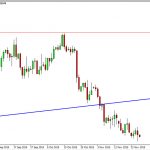Judging by how urgently Goldman’s research department is trying to get the bank’s clients to sell treasuries, Goldman’s prop traders must have a desperate bid for duration in anticipation of what probably will be a historic deflationary shock. It started a month ago when Goldman calculated that the US debt supply will more than double from $488bn to $1,030bn in 2018.

Then last Friday, Goldman revised its 10-year bond yield forecasts by around 20bp across the board – in part due to revised growth and inflation expectations – and now projects 3.25% for US Treasuries, 1.0% for Bunds, 2.0% for Gilts and 10bp for JGBs (the bank kept the peak level of Treasury yields in this cycle unchanged at 3.5-3.75%). Its full old vs new projection matrix is shown below:

Now, in yet another note meant to prompt selling of Treasurys (and buying of stocks that Goldman’s co-head of equities admitted last week he is all too willing to sell), overnight Goldman’s economist team wrote that “Federal fiscal policy is entering uncharted territory” after Congress “voted twice in the last two months to substantially expand the budget deficit despite an already elevated debt level and an economy that shows no need for additional fiscal stimulus.”
As a result of this historic expansion in U.S. borrowing during a period of economic growth, alongside rising bond yields, Goldman predicts a surge in the cost of servicing American debt, and goes so far as to warn that the current US fiscal trajectory would lead to catastrophe: “the continued growth of public debt raises eventual sustainability questions if left unchecked.”
* * *
What has so spooked Goldman, which rhetorically asks “what’s wrong with Fiscal Policy?” is that “US fiscal policy is on an unusual course. As shown in the left panel of Exhibit 1, we expect the budget deficit to widen over the next few years, as a result of prior imbalances and recently enacted policies, which should lead to a federal debt/GDP ratio of around 85% of GDP by 2021.”

“This stands in contrast to the typical relationship between the economic cycle and the budget balance, as shown in Exhibit 2. The result is a cyclically adjusted budget balance that we project to be wider over the next few years than at any time over the last 50 years with the exception of the 2009-2012 period following the financial crisis. In our view, this gap is driven by a combination of longer-term factors described below as well as the recently enacted tax cuts and spending increases.
For the non-fiscal conservatives, Goldman conveniently highlight the following: the US deficit should be small and shrinking, not large and growing.

The reason for this is that while revenues look likely to remain at the lower end of their historical range (over the last 50 years, revenues have fluctuated between around 15% and 20% of GDP, averaging about 17.5%), mandatory spending continues to grow. According to Goldman, and as shown in Exhibit 3, federal primary spending is at the higher end of the historical range, but looks likely to continue to increase as a share of GDP absent further policy changes.

Projected increases in mandatory spending—this includes Social Security, Medicare, Medicaid, and income support programs—are primarily responsible for this rise. Additionally, “health spending has continued to rise. While health care price inflation has remained subdued for several years, enrollment in federally subsidized health benefits has increased and recently released estimates by the Centers for Medicare & Medicaid Services Actuary anticipate an increase in spending growth in 2018-2020 due to an expected increase in the volume of care and an uptick in healthcare inflation.”













Leave A Comment